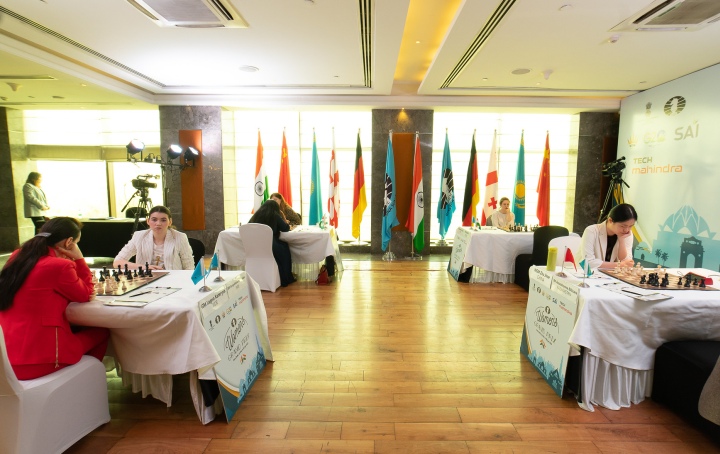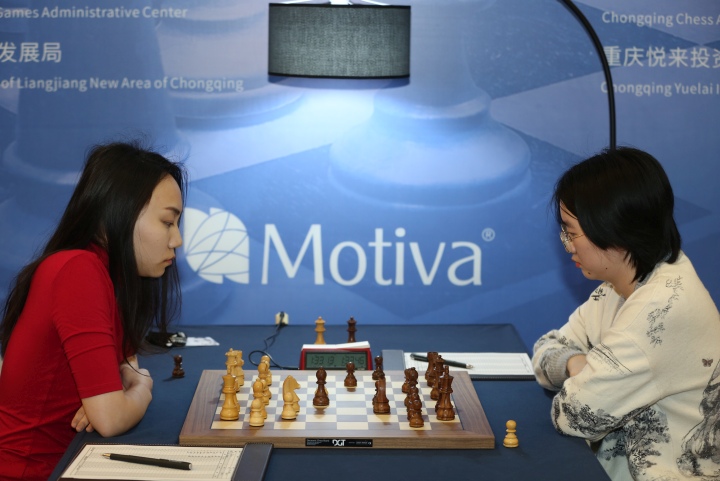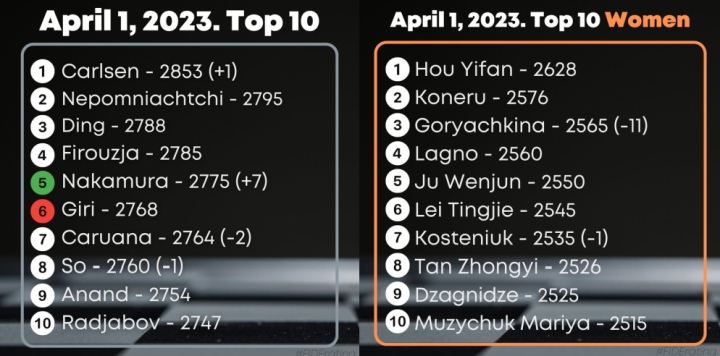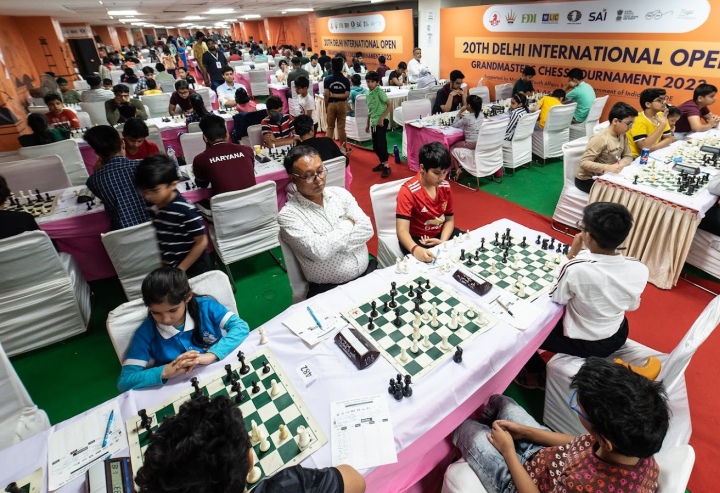WGP New Delhi: Round 10 Recap

Zhu Jiner’s critical victory and Aleksandra Goryachkina’s draw in the penultimate round of the Women’s Grand Prix in New Delhi have turned the tournament into a three-horse race. Sharing first place, Zhu Jiner, Bibisara Assaubayeva, and Aleksandra Goryachkina will all fight for the title in the final round Results of Round 10: Kateryna Lagno – Harika Dronavalli, ½ – ½ Polina Shuvalova – Aleksandra Goryachkina, ½ – ½Humpy Koneru – Nino Batsiashvili – ½ – ½ Zhu Jiner – Vaishali Rameshbabu – 1 – 0 Nana Dzagnidze and Bibisara Assaubayeva had a rest day. The 10th round of the Women’s Grand Prix in New Delhi started quietly with quick draws. Aleksandra Goryachkina was happy to split a point as Black against Polina Shuvalova after White decided to repeat moves in the early stages of the Catalan. It seems that Shuvalova has given up hope, while for Goryachkina a draw was enough to reach a shared first place ahead of the final round. The second quick game of the day was between Katerina Lagno and Harika Dronavalli. In the Berlin of the Ruy Lopez, the two went for a drawish exchange line and reached an even pawn endgame. Lagno now has 4½ points while Dronavalli is on 3½. The only decisive outcome of the day was produced in the game between China’s Zhu Jinerand India’s Vaishali Rameshbabu. Despite getting a solid position in the Benoni, Vaishali misplayed in the middlegame, and Zhu had no problem winning. This was a critical victory for Zhu as she now has 5½ points and has reached shared first place with Assaubayeva and Goryachkina. Humpy Koneru (playing as White) had a solid chance against Nino Batsiashvili in the Ragozin but failed to convert. Black had some initiative after the opening but could not find the best way forward, handing the advantage over to White. Despite creating a free-runner on the queenside, Humpy did not manage to convert this into a winning advantage and the game ended in a draw. Nana Dzagnidze and Bibisara Assaubayeva had a rest day today. In the final, 11th round, Assaubayeva faces a tough challenge against Kateryna Lagno, Goryachkina is up against Indian heavyweight Humpy Koneru, and Zhu Jiner plays as black against Nino Batsiashvili. Zhu has one more thing at stake – if she draws or wins her game in the last round, she will become a Grandmaster! With everything in the air and the closing ceremony scheduled to start at 7 PM local time on Thursday, the final round will start at 1 PM. Here follows a closer look at the games of the penultimate round of the Women’s Grand Prix in New Delhi. Kateryna Lagno – Harika Dronavalli This was a game between two very closely matched opponents who know each other well. Lagno and Harika have played 44 games so far, and the score is 11 wins for Lagno and 12 for Harika. It was the third consecutive game in which Lagno was playing as Black, due to two other players dropping out of the tournament after the pairing has already been made. This was a quick and largely uneventful game. Harika opted for the Berlin, and the opponents reproduced several well-known drawn games (Yang Wen – Li Di, Tari – Grischuk, to name a few) without making a single original move. As they reached the 30th move, after just over an hour of play, the two decided to draw. Polina Shuvalova – Aleksandra Goryachkina The two have played 16 games so far. Two wins for Polina and five for Goryachkina. This was the first game of the day to finish, and it lasted just under half an hour. In the Catalan, Shuvalova offered to repeat moves as early as move 11, while Goriachkina had no objection. A draw was agreed on move 15. Shuvalova has four points, but with this game she is suggesting that she just wants the tournament to finish so she can move on. Goryachkina, on the other hand, has everything to play for and was satisfied with a draw as Black. Humpy Koneru – Nino Batsiashvili The two have played only five games until now. Humpy leads 3:1 with one draw. The game progressed very slowly – both sides spent a lot of time in the opening. In a sharp line of the Ragozin, playing with white pieces, Humpy managed to come out of the opening in a slightly better position. On move 11, Black had to choose between so-called hanging pawns and an isolated pawn. Unlike Haik Martyrosyan in his game with Pragg, Nino opted for the former, and a fresh position emerged on the board. Nino decided to push d5-d4. After a series of logical moves, Black decided to voluntarily give up her c5-pawn for more activity but did not get sufficient compensation. Now Nino made an error. White was already a pawn up and had a solid position, so Black needed to play more actively if she wanted to do something with her initiative. The best option was 19…Qg5, pressuring e3 and g2 squares and activating her queen, or 19…Ne5, x-raying White’s queen down the c-file. Nino instead played 19…a5? and White now has a considerable advantage. 20.Bf5 and 21.Rd1, with then placing the rook on d7 was a path to victory. Humpy instead played 20.Qb3? and retained just a slight edge. An exchange of pieces on the queenside followed, and White ended with a free runner on the b-file, which was not that easy to advance. After 30.Rb7 Rxb7 31.Nxb7 Qe4 White gave up her b-pawn 32.Nd6 Qb1+ 33.Kh2 Nb4 34.Qc4. Humpy had a slightly better position, but with all the pawns on the kingside, it was not enough for victory. After four hours of play, the players agreed to split a point. Zhu Jiner – Vaishali Rameshbabu Despite both Zhu and Vaishali belonging to similar age groups (Zhu is 20, Rameshbabu is 21), the two have met only three times until this duel in New Delhi. In their previous matches, Zhu scored two victories and one
WGP New Delhi: Round 9 Recap

Goryachkina secures a crucial win against Dronavalli and is hot on heels of tournament leader Assaubayeva who settles for a draw against Dzagnidze The Women’s Grand Prix in New Delhi entered its decisive phase as Round Nine unfolded, with players gearing up for the final push in the remaining days of the tournament. Here are the results of today’s games: Bibisara Assaubayeva – Nana Dzagnidze, ½ – ½Vaishali Rameshbabu – Humpy Koneru, ½ – ½Nino Batsiashvili – Polina Shuvalova, 1 – 0Aleksandra Goryachkina – Harika Dronavalli. 1 – 0 Kateryna Lagno and Zhu Jiner had a rest day. With just two rounds to go, Bibisara Assaubayeva is in the lead with 5½ points. After eight consecutive games (she was free on day one), Assaubayeva will not play in the tenth round as she has another rest day. She is closely followed by Aleksandra Goryachkina, who is in second place after today’s victory. Ju Jiner (who had a rest day today) is on 4½ points. In today’s round, Bibisara Assaubayeva drew in the Neo-Catalan against Nana Dzagnidze. Assaubayeva, playing as White, had more initiative but couldn’t find a way to convert it into a decisive advantage. In the end, both were happy with a draw. In another Catalan, Aleksandra Goryachina defeated India’s Harika Dronavalli. The Indian player had more initiative but misplayed in the middlegame and ended up with two pawns down. Despite putting up fierce resistance, Goryachkina brought her opponent to defeat after just over four hours of play. Round Nine was lucky for Nino Batsiashvili, who scored her first victory in the tournament. In the Nimzo-Indian, playing as White against Polina Shuvalova, she took advantage of Black’s mistakes in the middlegame and won. Compatriots Vaishali Rameshbabu and Humpy Koneru had a peaceful debate in the Ruy Lopez and agreed to split a point after 31 moves. Here follows a closer look at the games of Round Nine: Bibisara Assaubayeva – Nana Dzagnidze Before this game, the two played five games in total. The small number of games is probably because the two belong to different generations. Bibisara has three victories, while Nana has only one, with one game ending in a draw. In the Neo-Catalan accepted, Bibisara deviated from the played lines on move nine, castling her king (other previously played lines include 0-0, Nxd7 or Na3) and got a tiny edge thanks to two bishops. The first important moment happened on move 17. In the post-game interview, Dzagnidze said that she ‘wasn’t sure’ about the 17…f5 move, as it opens some weaknesses in Black’s camp. The game proceeded with a lot of positional regrouping around the centre, hoping to advance. However, it seemed that Black was the side which had to wait and react to White’s actions. Assaubayeva opted to exchange dark-squared bishops and prepare a d3-d4 push through the centre. After several inaccuracies by Nana, Bibisara obtained a serious advantage. She had isolated d4-pawn, but this factor was outweighed by her serious pressure in the centre and on Black’s downward e6-pawn. Dzagnidze tried to wriggle out by 33…Rxd4, and it worked, but only because Bibisara wasn’t precise. She took on e6 with her knight when it was better to play 34.Bc6 first and then take on e6 with a rook. Playing 34.Nxe6 straight away Bibisara overlooked 34…Rd1!, which allowed Black to exchange some pieces and simplify the position. White was still better, but by move 37, her advantage dissipated, and the two soon agreed to draw. With this draw, Bibisara Assaubayeva is still at the top, with 5½/9, while Dzagnidze has 2½ points. Vaishali Rameshbabu – Humpy Koneru This was another Indian clash. Out of 14 games played, Vaishali has three victories, while Humpy has six. In a rare line of the Ruy Lopez, the two quickly exchanged central pawns and the queens, heading towards an endgame in which Vaishali exerted some pressure on the queenside. The best option for White was 17.Na5, to probing Black’s weakness and hampering her development. Instead, Harika opted for 17.Be3, allowing Black to activate her c8-bishop. It led to an equal position, and the two soon agreed to draw. A fourth draw for Vaishali, who now has two points, while Koneru has 3½ points. Nino Batsiashvili – Polina Shuvalova The two have played four times so far, and Nino has two victories while Polina has one. In the Nimzo-Indian defence, the two entered the Saemisch variation and followed the footsteps of Salem and Moussard (Dubai 2021) up to move ten, where Nino deviated with a very aggressive but questionable 10.f3-f4?! White has an impressive pawn center but has to be careful of overstretching, as it can easily become a weakness. Polina hastily castled (10…cxd4 11.cxd4 h5 looks stronger), and a very sharp game was on. Shuvalova spent significantly more time in the opening, suggesting that she was surprised by White’s preparation. Still, she countered well by timely chipping away at White’s center by b7-b5 and got a potentially very strong connected c and d pawns. Black is clearly better here. Chess engines suggest 20…Rae8, but Polina preferred 20…Ne7 and then launched operations on the “wrong” flank and allowed White to push the b-pawn to b6, giving her some advantage. It was the start of Shuvalova’s fall. She made several inaccuracies in a row and found herself in a very dangerous position. Black needed to move her queen away from the pinned c-file and suffer after 27…Qf6 28.Nxf5 Qxf5 29.Be5. Shuvalova instead decided to take on d4, ending in a net of pins on the c5 pawn. White could have won on the spot on move thirty with 30.b7!, but Batsiashvili opted for 30.Qc3 and left some chances for Black. Still, Nino preserved a large part of her advantage. Shuvalova’s best option was to exchange her knight for the bishop on e5 but she played 33…d4? instead, further weakening her central pawns. The rest of the game was a walk in the park for White as her passers advanced much faster. Shuvalova soon resigned. It is the first victory for Nino Batsiashvili
Lei Tingjie wins Women’s Candidates Final

With a final score of 3½-1½, and with a game to spare, Lei Tingjie defeated Tan Zhongyi in the Women’s Candidates Final and will now challenge Ju Wenjun in the upcoming Women’s World Championship match, scheduled for July in Shanghai and Chongqing. In a must-win situation – a draw would leave Lei Tingjie with the white pieces in the last round with draw odds – Tan Zhongyi whipped out the Colle-Zukertort system, a rare bird in top-level events, but extremely popular at the club level. According to my database, in more than 600 official tournament games playing White, Tan Zhongyi has never employed this variation before: a risky choice for such an important game. The surprise effect didn’t work out. Lei Tingjie reacted fast, demonstrating splendid match-play opening preparation. She uncorked a novel idea (7…g6!?), delaying castling in favour of a dangerous kingside pawn avalanche. Although the line has been tried out on a few occasions by +2500 grandmasters in the past (notably Lopez Martinez and Cornette), it’s clearly not mainstream. By move 14, Black had already taken over the imitative on the kingside. Although the engines were still offering an equal evaluation, and the situation on the clock was also similar, it did feel that Lei Tingjie was playing aggressively to end the match here and now. The key moment of the game came unexpectedly. Under certain pressure on her castled king, Tan Zhongyi played 21.g3? breaking the golden rule of not moving the pawns in front of your king unnecessarily. Lei Tingjie’s masterful reply 21…Nd8!! highlighted immediately White’s new weaknesses in her castled king position. The manoeuvre Nd8-f7-g5-f3 would prove to be decisive. In the commentary booth, GM Alik Gershon was bowled over: “Wow! Look what Lei did: 21…Nd8! This is extremely impressive! She reacts immediately to 21.g3, which has a very serious drawback – it weakens the f3 square.” From then on, it was plain sailing for the new Women’s World Champion contender. All of Black’s pieces surrounded White’s king, and after 33…Rxg4 the attack crashed through and it was all over for Tan Zhongyi. A fine attacking game by Lei Tingjie that topped off her dominant performance in the match. Text: IM Michael Rahal Photo: Liu Yi Official website: womenscandidates.fide.com/ The match The 2023 FIDE Women’s Candidates Final is being disputed in Chongqing (China) from March 27th to April 6th. Chinese Grandmasters Lei Tingjie and Tan Zhongyi face each other in a six-game classical chess match. The winner will receive 60.000 euros and the right to challenge the current Women’s World Champion Ju Wenjun for the title in July. The venue Strategically positioned as a gateway to China’s west, Chongqing is China’s major modernized manufacturing base, a financial center, and an international transport hub in Western China. Home to more than 32 million people, it was an obvious choice for hosting the event as both players were born in the city. In addition, it’s an important center of chess activity in the country, abode to many important chess clubs and academies. A fun fact – both Lei Tingjie and Tan Zhongyi are teammates at the Chongqing Sports Lottery Chess Club.
WGP New Delhi: Round 8 recap

Bibisara and Zhu draw as Goryachkina makes a lucky escape in a completely lost position against Lagno Two games ended in a draw and two with a victory for White in Round Eight of the Women’s Grand Prix in New Delhi. Here are the results of today’s games: Kateryna Lagno – Aleksandra Goryachkina, ½ – ½ Harika Dronavalli – Nino Batsiashvili, 1 – 0 Polina Shuvalova – Vaishali Ramehsbabu, 1 – 0 Zhu Jiner – Bibisara Assaubayeva, ½ – ½ Nana Dzagnidze and Humpy Koneru had a rest day. The game between two favourites of the Grand Prix series, Kateryna Lagno and Aleksandra Goryachkina, ended in a surprising draw. In the Berlin of Ruy Lopez, Goryachkina badly misplayed in the middlegame allowing White to dominate. After nearly five hours of play, Lagno was completely winning. The position needed some calculating, but Lagno was desperately low on time, so she decided to repeat the moves. Bibisara Assaubayeva played the King’s Indian against Zhu Jiner and achieved an even position but was not fully comfortable with her perspective. Both tried to find a way to victory but were satisfied with a draw and were the first to finish. Polina Shuvalova defeated Vaishali Ramehsbabu in the Gruenfeld Defence. Shuvalova was the one who made fewer errors in the game, which saw both sides win and drop advantages. Due to time trouble, Vaishali overlooked a dangerous attack by Black and had no choice but to resign. Harika Dronavalli had a lucky break as she managed to turn a worse position into a victory against Nino Batsiashvili. After outplaying her opponent in the Ruy Lopez, Nino Batsiashvili could not find the right plan and first allowed her opponent to equalize and then blundered, ending in a lost position. With three more rounds to go, Bibisara Assaubayeva leads with five points, while Zhu is second with 4½. Goryachkina and Lagno share third place with four points. Here follows a closer look at the games of Round 8. Kateryna Lagno – Aleksandra Goraychkina This was a duel between two strong favourites in the Women’s Grand Prix as well as two closely matched players. Out of 18 games played between them, each has three victories, with other games ending in a draw. In the Berlin variation of the Ruy Lopez, Lagno went for the closed line (with 4.d3) to avoid the endgame and emerged slightly better thanks to greater spacial control in the centre. Goryachkina played 18…c5 here, closing her bishop on a7 and allowing White to make a push through the centre with 19.e5! After 19…dxe5 Lagno should have put her d-knight on f5 to maintain the initiative. Instead, she retreated this piece with 20.Nf3 and now after 20…Qd6 the position roughly even again. In the subsequent play, Black sacrificed her a5-pawn. White eventually planted one of her knights on f5 and opened up the centre with 27.f4. Goryachkina’s reaction was suboptimal as Lagno regrouped her pieces and got the upper hand. White is dominant all over the board: she is a pawn up, has more space, more initiative, better coordination of pieces and is preparing a direct attack on Black. However, Lagno had one problem – the clock. She was desperately down on time, with just under two minutes, while Goryachkina had nearly half an hour. Goryachkina now made what a fatal error: 36…Qxc4. Now White could break the black king’s fortress and win the queen with 37. Nxf6+ gxf6 38. Qg3+ Kf8 39. Ng6+ Kg8 40. Ne5+ Kh8 41. Nxc4 and that would have been it. Lagno missed this and played 37.bxc5 and sacrificed the knight only after 37…Ba5 38.Nf6+ gxf6 White had a win that was not so difficult to find. Namely, 39.Qg3+ Kf8 (Kh8) 40.Kg6+ Kg8 41.Rxe8 Bxe8 42.Rxe8 Rxe8 43.Ne5+ capturing the queen. However, with just seconds on her clock, Lagno played 39.Rxe8 Bxe8 40.Re4 (White has an overwhelming position, but there is no immediate win anymore) Qd5 41.Rxd4 Qxc5 42.Qg3+ Kf8 43.Ng6+ Kf7 and here White forced a draw by perpetual 44.Nh8+ Kf8 It is hard to blame Kateryna for missing 45.Rd7!! winning. She may have seen that move, but could not have managed to find and check all the lines afterwards. The game ended in a draw after 45.Ng6+ Kf7 46.Nh8 Kf8. Goryachkina had a very lucky escape today, and Lagno was clearly displeased with the outcome. Goraychkina and Lagno are now both on four points. Harika Dronavalli – Nino Batsiashvili The two have played six times so far and Harika was in the lead with two to one in victories, and there were three draws. This was an important game for both sides as neither has scored a victory in this tournament until this round. Harika started with 1.e4 instead of her usual 1.d4 or 1.Nf3. Batsiashvili replied with 1…e5, and the two proceeded with the Archangel variation of the Ruy Lopez. The same line was played between Lagno and Batsiashvili in Round Six, ending in a draw. Harika closed the centre with d4-d5 but completely misplayed the opening and ended up a pawn down with no real compensation. However, Black did not find the right plan (a straightforward 18…Bxe3 19.fxe3 a5 followed by 20…a4 looks highly unpleasant for White) and let her advantage slip away. By move 25 White equalized after making a thematic push c4-c5. Both opponents made small inaccuracies in the final portion of the game, but it was Nino who buckled under pressure. 38…Re8? and after 39.Ra2! Ra5?? 40.Qh6 White is crushing, combining the threats to Black’s king with the pressure along the c-file. Harika finished the game with an effective tactical blow. 46.Ne6! Fxe6 47.Rf3+ and Black will lose her queen, 1-0. Polina Shuvalova – Vaishali Rameshbabu Out of 14 games played between the two, the score is 7:6 for Shuvalova, with only one draw. In all the previous games where she was White against Vaishali, Polina opted for 1.e4, but this time she played her first move with the queen’s pawn. The game saw the line with 6.Bb5+ in the Gruenfeld Defence with the opponents following the encounter Graf – Kovchan (Warsaw, 2005) up to move
WCF Game 4: Lei Tingjie strikes hard and fast

Fully recharged after their well-deserved rest day, Lei Tingjie and Tan Zhongyi returned to the playing venue in Chongqing this afternoon for the second half of their six-game match. Tied 1.5-1.5 on the scoreboard, the three final games will decide which of the two Chinese Grand Masters advances to the next stage of the cycle: challenging the current Women’s World Champion Ju Wenjun, for the title in July. Playing with Black, Tan Zhongyi deviated from the second game of the match with 3…Nf6 instead of 3…dxc4, a solid choice for this game. Lei Tingjie brought the trendy Catalan Opening to the table, a decision that caught her opponent off-guard, as she explained in her postgame interview. Following seventeen moves of well-known theory, the first key moment of the game came on move eighteen when Tan Zhongyi created some weaknesses in her position by advancing 18…f5. According to the engines, Black is seriously worse after this move, as it weakens her kingside considerably. Tan Zhongyi explained that the structure was slightly unfamiliar to her and that she wanted to consolidate her central knight on d5. A few moves later, 21.f4 might have been a slightly better move than 21.Na5, preventing Black’s counterplay in the center, but even so, White still kept the upper hand. However, Tan Zhongyi gradually fought back into the game, generating enough initiative on the kingside to compensate for her opponent’s queenside domination. The second key moment could have turned the tables completely. Lei Tingjie blundered with 28.b3? but Tan Zhongyi’s reply 28…Nc8 was no good. Instead, she could have played 28…fxe4 29.fxe4 Rxf1 30.Bxf1 and now the masterstroke 30…Nxd5! sacrificing a piece that can’t be accepted. The knight can’t be captured with the rook due to 31…Qe3+ winning, while 31.exd5 runs into 31…e4! and Black is winning wherever the rook moves to. It’s hard to say what Tan Zhongyi missed in this line – she had more than 50 minutes on the clock and only spent 4 minutes on her decision. In any case, in her postgame interview, she regretted not having played this move. Lei Tingjie didn’t give her a second chance. She started piling up the pressure, and when Tan Zhongyi ventured her rook into Lei’s position to win a pawn, she struck hard and fast at her opponent’s king, building up a decisive attack that eventually forced her opponent to resign. In her postgame interview, Lei Tingjie said that today’s game was very complicated. She mentioned that she saw Tan’s missed tactical opportunity and was very nervous. Finally, she explained that she was very lucky to win in the end. After answering the questions, Lei dashed off to dinner: she was so nervous during the game that she forgot to drink water for four and a half hours, and now she was very hungry! Both players will return tomorrow for the fifth game. Tan Zhongyi will be playing with White for the final time, in a must-win situation. You can follow all the games with with top-notch commentary by GM Alik Gershon and WIM QiuMengjie on the FIDE YouTube Channel. Text: IM Michael Rahal Photo: Liu Yi Official website: womenscandidates.fide.com/ The match The 2023 FIDE Women’s Candidates Final is being disputed in Chongqing (China) from March 27th to April 6th. Chinese Grandmasters Lei Tingjie and Tan Zhongyi face each other in a six-game classical chess match. The winner will receive 60.000 euros and the right to challenge the current Women’s World Champion Ju Wenjun for the title in July. The venue Strategically positioned as a gateway to China’s west, Chongqing is China’s major modernized manufacturing base, a financial center, and an international transport hub in Western China. Home to more than 32 million people, it was an obvious choice for hosting the event as both players were born in the city. In addition, it’s an important center of chess activity in the country, abode to many important chess clubs and academies. A fun fact – both Lei Tingjie and Tan Zhongyi are teammates at the Chongqing Sports Lottery Chess Club.
Autism Awareness Day: FIDE Infinite Chess project outlook

United Nations recognize April 2 as an Autism Awareness Day. At FIDE, we’re determined to help children with ASD learn chess. Chess improves social skills, reduces anxiety, and facilitates overall development. Our INFINITE CHESS Project started in 2019 as a small pilot project. In three years, it has gained momentum and expanded to 10 countries: Albania, France, Gibraltar, Latvia, Malaysia, Mongolia, Morocco, South Africa, Spain, and Turkey. You can watch a special video dedicated the the Project’s outlook on our YouTube. “Chess is an excellent tool to make societies better. With social chess initiatives, FIDE educates youth, empowers women, integrates less privileged and finds new ways to satisfy all special needs. Building on practical experiences of teachers who work with childern with autistic spectrum disorder (ASD), FIDE has devised the Infinite Chess project, where chess is used for improving the socio-emotional welfare of such special kids,” says the project leader, WIM Anastasia Sorokina. The Project runs in cooperation with FIDE Social Commission. It aims to increase knowledge and awareness of chess for children with autism spectrum disorder (ASD) and study the benefits of introducing them to chess. We develop various teaching methods and give practical advice to teachers and parents. INFINITE CHESS timeline: In January 2021, a pilot project was launched in 6 countries: Spain, Turkey, France, Gibraltar, South Africa and Norway. In Spring 2021, an introductory FIDE seminar took place, attracting 130 participants from more than 50 countries. On October 2-3, 2021, FIDE organized the 2nd FIDE Educational Seminar, “Chess for children with an autism spectrum disorder. Learn and teach”. In 2022, the Project onboarded Asian and African countries: Malaysia and Mongolia, South Africa and Morocco. In December 2022, the Conference “Chess for Social benefits and Women Inclusion & INFINITE CHESS Evolution” took place in Paris, France. On March 29, 2023, dedicated to the World Autism Day, the workshop for educators was held in South Africa under the guidance of Erick Takawira, Councillor of the FIDE Social Commission. With the support of the International Olympic Committee, the first educational program was launched: “Methodological guide for teachers to conduct chess classes when working with children with autism spectrum disorder”. In the meantime, an Erasmus funding application was submitted in order to carry out extensive research. The program is available in four languages, English, French, Spanish, and Russian. You can download it here: Program – FIDE Infinite Chess Project Our dedicated YouTube playlist collects the conference and seminars that have been conducted so far, and we welcome everyone to check these materials: INFINITE CHESS PLAYLIST Join us at infinitechess.fide.com!
FIDE April 2023 rating list published

The main chess competitions in April had little impact on the top 10 Open and Women. The only exception was the American Cup 2023, won by Hikaru Nakamura. The American picked up 7 rating points and returned into The top 5 Open. Ironically, the runner-up, Wesley So, dropped one rating point in this event. Photo: St-Louis Chess Club | Crystal Fuller On the other hand we see some significant shifts in the lower echelons of top 100. Biggest gains in top 100 Open and Women Vantika, Agrawal WGM 2407 (+40) Lee, Alice FM 2391 (+29) Kiolbasa, Oliwia IM 2429 (+23) Maltsevskaya, Aleksandra IM 2410 (+22) Sarana, Alexey GM 2685 (+17) Mkrtchyan, Mariam WIM 2360 (+17) Shevchenko, Kirill GM 2684 (+16) Tsolakidou, Stavroula IM 2373 (+15) Garifullina, Leya IM 2384 (+12) Yakubbaeva, Nilufar WGM 2362 (+13) Photo: Madelene Belinki The winner in this nomination Vantika Agrawal of India (pictured above), scored impressive 40 rating points following her successful tour in Hungary, where she performed strongly at GM tournaments in Vezerkepzo and Budapest. Alice Lee made a strong showing in the 2023 American Cup, making all the way to the final, where he lost to the eventual champion Irina Krush. This result translates into 29 rating points accumulated by the talented teenager in March. Photo: St-Louis Chess Club | Lennart Ootes The top finishers of the European Championship (Open), Alexey Sarana and Kirill Shevchenko, earned 17 and 16 points, respectively, and both moved 20 positions up in the rating list. It is encouraging to see that this event became a springboard for several talented youngsters outside of the top 100 open who substantially increased their rating: Daniel Dardha (+15, pictured below), Volodar Murzin (+23), Nikolozi Kacharava (+19), Frederik Svane (+17) and Ediz Gurel (+35). Photo: eicc2023.com/ As for the Europeans Women’s Championship, the primary rating beneficiaries of this competition are the runner-up Oliwia Kiolvasa (+23), the bronze-winner Aleksandra Maltsevskaya (+22) and Stavroula Tsolakidou (+15). Just like in the Open section, several female youngsters – Mariam Mkrtchyan, who returned into the top 100 Women (+17), Yelyzaveta Hrebenshchykova (+14) and Nadya Toncheva (+85)! – picked up quite a few rating points following the European Women’s Championship.
WGP New Dehli: Round 7 Recap

Bibisara Assaubayeva made her first draw in New Delhi but is still in the lead with 4,5 points. The race for the top is heating up as both Lagno and Goryachkina scored Round 7 saw two decisive outcomes and two draws. It was a relatively short round, with the last game finishing after three and a half hours of play. Round 7 results: Nana Dzagnidze – Kateryna Lagno, 0 – 1Bibisara Assaubayeva – Humpy Koneru, ½ – ½Vaishali Rameshbabu – Harika Dronavalli – ½ – ½Nino Batsiashvili – Aleksandra Goryachkina – 0 – 1 In the seventh round of the Women’s Grand Prix in New Delhi, Bibisara Assaubayeva made her first draw of the event against Humpy Koneru, playing the Reversed Benoni. Although Assaubayeva had a better position, she couldn’t find a path to victory. Despite this, the player from Kazakhstan still leads the tournament with 4,5 out of 6 points. Koneru has three points. Meanwhile, Aleksandra Goryachkina took another step towards the top, capitalizing on a blunder by Nino Batsiashvili in Veresov. Kateryna Lagno also had a successful match against Nana Dzagnidze, taking advantage of Nana’s misplay in the Bogo-Indian to secure a win. Lagno and Goryachkina both have 3,5 points, but Goryachkina has one game more. The Indian derby between Harika Dronavalli and Vaishali Rameshbaby, ended in a draw. Vaishali has 1,5 points while Harika has two. Here follows a more detailed look at the games of Round Seven in the Women’s Grand Prix: Nana Dzagnidze – Kateryna Lagno In the huge number of games the two have played, Lagno leads by a significant margin. Nana forgot her moves in the opening and spent a lot of time in a rare line of the Bogo-Indian. Kateryna sacrificed a pawn early on and got some compensation but hardly more. On her fourteenth move, however, Dzagnidze made a serious mistake. Here White should play 14.a3, but Nana forgot the line and played 14.f4? allowing Black to create a strong pawn centre and obtain a serious space advantage, which Kateryna used to align her pieces for the attack. After due preparation, Black started her onslaught on the white king. Nana had just one way to stay in the game for a while by putting her rook on f1, to protect and control the f4 square. Instead, she played 23.Qc2?, allowing Black to open the g-file with deadly threats. 23…gxf4 24.gxf4 Qh4 – White has no escape. The final portion of the game turned into a hunt for the White’s king that ended on move 29. Leaving the playing hall, Nana Dzagnidze briefly commented that “one can’t play when they forget or don’t know the lines”. Despite a challenging tournament, Nana Dzagnidze is maintaining a courageous demeanour and refraining from displaying any overtly negative emotions. Lagno now has four points, while Dzagnidze is on two. Bibisara Assaubayeva – Humpy Koneru This was the first classical game between Assaubayeva and Koneru. So far, they have played 23 Blitz games with an even head-to-head record. Just like in the encounter between Assaubayeva and Dronavalli, the game saw the Reversed Benoni and, again, White emerged clearly better in the opening. In the post-game analysis, Koneru explained that here she misplayed the line – she should have continued with 10…c6 but played 10…Re8. Bibisara had an extra pawn with no visible compensation for Black. On move 16, White had a chance to increase her advantage by grabbing the b7-pawn but Assaubayeva opted for a safer approach. Little by little, Koneru coordinated her pieces and countered by pushing the a-pawn and then activating her kingside pieces, to force exchanges and blunt White’s edge. Despite not finding the best moves, White had a better position for most of the game, although to Koneru’s credit, she put up a stubborn resistance. In the end, as both reached time trouble, it all turned around as Assaubayeva handed her advantage to Black. Sensing the moment, Assaubayeva made a good practical decision by offering a draw in the following position after 37.f3 Koneru was better here: Black just needs to realign her heavy pieces on the kingside and put pressure on White’s centre. However, Humpy was not in the mood to continue, and the two agreed to split a point. This is the first draw for Bibisara Assaubayeva who now has 4,5 points out of six games. Humpy Koneru has three points. Vaishali Rameshbabu – Harika Dronavalli In the Indian duel between Vaishali and Harika, out of 17 games played between the two, Vaishali won nine, and Harika won eight. In the Open variation of the Ruy Lopez, the opponents tested a rare line and quickly stepped off the beaten track. Both played quite logical natural moves keeping position in balance. Following exchanges and simplifications, the two reached an even rook endgame and called it a day. Dronavalli is on two points while Rameshbaby is on 1,5. Nino Batsiashvili – Aleksandra Goryachkina Out of the total of 13 games the two have played so far, Nino has two wins and Goryachkina has four. In the Veresov with 3.Bf4, the two entered unchartered waters as early as move six. Batsiashvili went for an unusual move 6.Nh3 but after natural 6…Bb4 played by Goryachkina, Black was already slightly better. A more logical move was 6.h4, heading into a sharp position. After Nino closed the centre on move eight, Aleksandra got a very good version of advanced Karo-Cann with a couple of White’s pieces misplaced. White’s uncastled king is exposed, and the centre is hanging by a thread. White should have proceeded with 13.dxc5 to remove the c5 pawn, countering Black on the left flank and centre. Instead, 13.b4 played in the game was premature and, costly. After the game, Nino explained that the occasional noise coming from another part of the hotel affected her concentration, and she misplayed. After 13…cxb4, instead of taking 14.axb4 and continuing resistance in a worse position, Nino played 14.Nb5? – a well-known idea in the French Defence, that just doesn’t work here. It failed to 14…Bxc2! 15.Qxc2 b3+ 16.Qd2
Aravindh Chithambaram wins 20th edition of New Delhi Open

The 20th edition of the spectacular New Delhi Open, in which 1057 players took part, ended with the victory of Indian GM Aravindh Chithambaram, while GM Luka Paichadze of Georgia finished as first runner up. In what is in the West now, mostly a memory from the heyday of chess popularity, India has hosted its biggest tournament – the New Delhi Open – in a stadium. The jubilar 20th edition of the New Delhi Open (started in 2003) took place at the Jawaharlal Nehru Stadium, named after the first Prime Minister of India, and is the fourth biggest stadium in the country. Traditionally, the tournament is held at the Indira Gandhi Stadium, the largest indoor sports arena in the country, but due to the World Women’s Boxing Championship, it had to be moved. The New Delhi Open has become a beacon for chess enthusiasts around India, attracting nearly 3000 players annually. The event has three different categories: one is the GM Open, then B category, below 1999 rating, and C category, below 1599. While the event traditionally takes place every January, due to the rise in Covid cases in India at the start of the year, it was postponed. The initial prize fund was $153,000 in three categories, but due to health and safety, the organisers decided to have the event in just one – top category, with a prize fund of $55,000. Altogether, 19 Grandmasters and a number of IMs and FMs from over 10 countries took part in the event. The second seed Aravindh Chithambaram (India, pictured below), turned in an excellent performance and came out on top, scoring a spectacular 9.5/10. Luka Paichadze (Georgia) finished just a half-point behind the winner. As many as six participants netted 8.5/10, with the top seed GM Sethuraman S P (India) taking third place thanks to superior Buchholz. The excitement at the New Delhi Open was further amplified as it coincided with the third leg of the Women’s Grand Prix. The atmosphere was electrifying as both events showcased the very best of chess. “India has become a chess nation, and the New Delhi Open is a beacon of our success. With numerous Grandmasters and thousands of young players participating from all corners of the country, this event has become an annual celebration of our love for the game. And with the successful hosting of the Olympiad, we are committed to promoting chess in India and transforming our country into a true superpower in chess,” said Bharat Singh, Director of the New Delhi Open and a key figure in the All India Chess Federation. Final standings: 1 GM Aravindh, Chithambaram IND 2607 9½ 2 GM Paichadze, Luka GEO 2515 9 3 GM Sethuraman, S.P. IND 2639 8½ 4 GM Savchenko, Boris FID 2552 8½ 5 GM Kobalia, Mikhail FID 2577 8½ 6 AIM Vaz, Ethan IND 1949 8½ 7 GM Krasenkow, Michal POL 2527 8½ 8 GM Aleksandrov, Aleksej FID 2484 8½ 9 GM Murzin, Volodar FID 2554 8 10 GM Mchedlishvili, Mikheil GEO 2569 8 The top eight finishers of the New Delhi Open earned FIDE Circuit race points based on the final standings: 1. 7,99 2. 6,39 3. 4,59 4. 4,19 5. 3,79 6. 3,39 7. 3,00 8. 2,60 Complete results Text: Milan Dinic Photo: Ismael Nieto
WGP New Dehli Round 6 recap: The halfway point

Bibisara Assaubayeva defied the odds and secured a remarkable victory against Polina Shuvalova, despite initially facing an uphill battle. The three other games ended in a draw As the Women’s Grand Prix tournament in New Delhi reached its halfway point, Round Six brought an electrifying array of games to the forefront. With all four boards featuring sharp and skilful play, it’s a surprise that just one game finished with a decisive result. Round 6 results: Kateryna Lagno – Nino Bastiashvili, ½ – ½Aleksandra Goryachkina – Vaishali Rameshbabu, ½ – ½Polina Shuvalova – Bibisara Assaubayeva, 0 – 1Zhu Jiner – Nana Dzagnidze, ½ – ½ Bibisara Assaubayeva is the biggest winner of the day overturning a lost position against Polina Shuvalova. Assaubayeva got into trouble early on, after forgetting the opening. Shuvalova missed several good chances to seal the victory and, in the end, lost. Assaubayeva is the only player in New Delhi who had decisive results in all of her games so far. In a second surprise of the day, Zhu dropped a huge advantage against Nana Dzagnidze following Black’s misplay in the Najdorf. Despite achieving better positions, Kateryna Lagno and Aleksandra Goryachkina could not find the right way forward and ended up drawing their games. Zhu Jiner and Bibisara Assaubayeva are now joint leaders with four points, though the latter has played one game less. Here follows a more detailed look at the games of Round Six. Kateryna Lagno – Nino Batsiashvili Out of four games the two have played until New Delhi, Lagno won three and Batsiashvili one. In a rare line of the Archangel variation in the Ruy Lopez, Nino seemed to be uncomfortable. Lagno went for a strike in the centre with 8.d4 and got the upper hand. However, Kateryna couldn’t find the best way forward and started spending significantly more time. Instead of 18.Bf4, attacking the e5 knight and opening the path for the a1 rook to get involved in the game, White went with 18.Bg5. Batsiashvili responded resourcefully, exchanging her passive pieces for White’s attacking pieces, erasing White’s advantage. After exchanges and simplifications, this was now an even rook and bishop endgame. It did not take too long for the opponents to shake hands and split a point, right after reaching the time control. The two players spent some time after the game discussing and analysing the positions. In the post-game interview, Lagno pointed out that Batsiashvili did not know the opening line well. “I had a better position but I couldn’t find the right way forward,” Lagno said. Kateryna Lagno now has 2,5 points out of five games, while Batsiashvili is on 1,5. Aleksandra Goryachkina – Vaishali Rameshbabu Goryachkina and Vaishali have played seven games so far. Somewhat surprisingly, the young rising star from India leads with three victories and four draws against the current World number two player! Their eighth game saw a popular line of the Gruenfeld Defence, extensively tested on the highest level. The opponents followed the encounter between Anish Giri and Ding Liren up to move 17 when the Indian deviated with 17…f6 and grabbed White’s e4-pawn. Aleksandra got more than sufficient compensation but stumbled at a critical moment. Goryachkina spent nearly 40 minutes(!) thinking but instead of 20.Bd7 followed by 21.Rc7 with considerable pressure, she played 21.Qe3, which wasn’t the best choice. This allowed Black to relieve the tension with a timely 20…e5 and activate her pieces, leading to an even position. The two played on, but the evaluation of the position was not changing: White had sufficient compensation for a pawn but hardly more. A draw by perpetual came as a logical outcome. In a post-game interview, Goryachkina said that she felt that she was better but that she couldn’t find the right move forward. Goryachkina now has 2,5 points out of four games played, while Vaishali has one point with the same number of games. Polina Shuvalova – Bibisara Assaubayeva Facing the King’s Indian Defence on the white side, Shuvalova opted for a very sharp Four pawns attack and, after advancing her kingside and central pawns, got a clear advantage. Still, White had to put her king to safety – 12.0-0, which was the most natural and strong continuation. After 12.exd6 Nb6 White was still better, but overambitious 13.f5 led to an unclear position. Bibisara immediately returned the favour by 13…exd5 and after 14.Bf4 Nc4 15.Bxc4 dxc4 White was in command again. However, instead of natural 16.Qd2 Ng8 17.0-0-0 with a crushing attack, Polina played 16.f6? giving up a pawn and dropping her advantage. Black’s reaction was far from optimal, and Polina obtained a decisive advantage one more time. The pendulum kept swinging as Shuvalova missed another opportunity to seal the deal. Instead of 20.Nd5 (or 20.Rxe8 Qxe8 21.Nd5) she opted for 20.Ng5? and after 20…Rf8 21.Qd5, the position was equal. White’s woes did not end there. Black already achieved some counter-play in a roughly even position, but here Polina made a step into the abyss: 24.Kg3?? After 24…Bb7 25.Rh2 h6 26.h4 Qd7 27.Nce4 h5 Black was completely winning. Three moves later, Shuvalova threw in the towel. A great misfortune for Polina Shuvalova, and a lucky break for Bibisara Assaubayeva. Assaubayeva now has four points out of five games, while Shuvalova is on 2,5 and is bye on day seven. Zhu Jiner – Nana Dzagnidze Up to this round, Zhu has one victory and two draws with Nana Dzagnidze. The opponents tested a very sharp line of the Najdorf Sicilian, in which White missed a chance to sacrifice a piece for a dangerous initiative Zhu opted for 11.Bb3, but a stronger move was 11.Bxe6 fxe6 12.Nxe6 with excellent positional compensation and continuous pressure. The Chinese player went for a more cautious approach and still came out with a preferable position. White is better: she has two strong knights in the centre, threatening to take on g5 and then press on the f7 and d8 squares, endangering Black’s weak king. Dzagnidze’s best option was to play 16…Be7 to guard the d8-square and try and move her king to safety. Instead, she blundered with 16…Nxb3? After 17.axb3, there is no escape for Black. However, at

